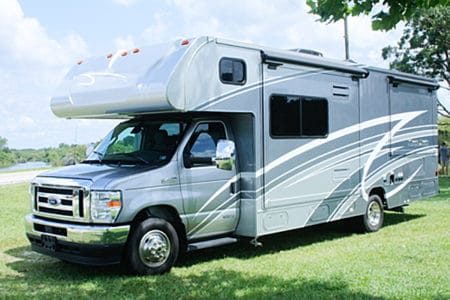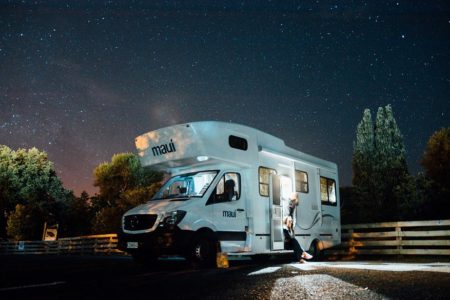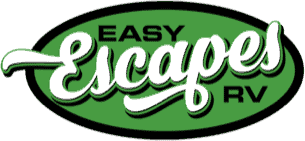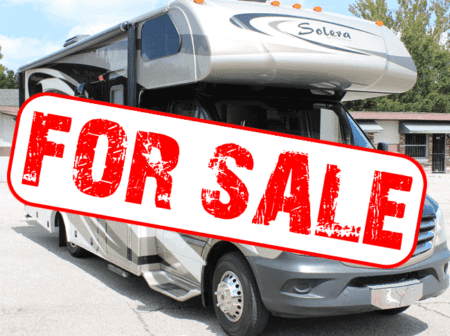Selling a used RV in today’s competitive RV buyers market, it’s crucial to have effective advertising strategies that help your Camper stand out from the crowd.
With so many options available to potential buyers, it can be challenging to capture their attention and convince them to choose your RV over others.
However, with the right strategies and tactics, you can increase your chances of making a successful sale.
In this blog post, we’ll cover some RV marketing strategies that we use here at Easy Escapes RV to help us stand out and attract potential buyers.
Is the RV Craze Over?
The COVID-19 pandemic caused a surge in Recreational vehicle sales as people sought safe and socially distanced travel options.
As a result, RV sales reached new heights in 2020 and the trend continued into 2021. However, some people are now wondering if the RV craze is over and if sales will begin to decline.
While it’s difficult to predict the future of the entire market let alone the local market, some experts believe that sales may start to slow down as the pandemic subsides and travel patterns shift back to pre-pandemic levels.
However, others predict that the RV lifestyle will continue to be popular and that sales will remain strong.
RV sellers need to stay up-to-date on RV sales trends and adjust their advertising strategies accordingly.
Keeping an eye on industry news and trends can help you make informed decisions about RV marketing and when and how to sell a used RV.
1. What Is the Fair Market Value of an RV?
Determining the fair market value of an RV can be a complex process, as it depends on several factors such as the age, condition, and features of the your camper.
However, several resources can help RV sellers determine a fair asking price.
One of the most popular resources for RV pricing is the NADA Guides, which provides pricing information needed when selling a used RV. Factors such as make, model, and year.
Other resources for Motorhome pricing include RVTrader.com, RVvaluesonline.com, and RVUSA.com.
When determining the fair market value of a Travel Trailer, it’s important to consider factors such as the RV’s mileage, condition, and history.
RV sellers may also want to factor in the cost of any repairs or upgrades they’ve made to the recreational vehicle, as these can increase the vehicle’s value.
It’s also important to keep in mind that camper pricing can vary depending on the region and market demand.
RV sellers may want to do some research on local pricing trends and adjust their marketing strategies and asking prices accordingly.
Here are a few resources for RV pricing information:
2. Define Your Unique Selling Proposition (USP)
Your unique selling proposition is what sets a RV apart from others on the market.
It’s the key selling point that differentiates your RV from others and can help attract potential buyers. Your USP could be anything from the size of your camper to its unique features and amenities.
By clearly defining your USP, you can tailor your digital advertising strategies to highlight these unique features and help your recreational vehicle stand out in a crowded market and help considerable in selling a used RV.
One crucial step to selling a used RV is to write an effective listing that will attract potential buyers.
This listing is what buyers will use to make their purchasing decisions, and if it is not well-written, you may not attract the right buyers or even attract any at all.
This is why we have compiled some tips to help you write an effective RV listing that will get you offers from potential buyers.

3. Use High-Quality Photos and Videos
When it comes to RV advertising, high-quality photos and videos, and virtual tours are essential marketing materials.
Potential buyers want to see detailed images that showcase a RV’s unique features and amenities.
Invest in professional photography and video services to capture your Motorhome in the best light possible.
Consider creating a virtual tour of your recreational vehicle to give potential buyers a comprehensive look at the interior and exterior of your RV.
4. How to write an effective RV listing.
Along with great photos, a well-written listing can also help your travel trailer stand out in a competitive market.
Start with a Catchy Headline
Your headline is the first impression buyers will get and it is, therefore, essential to make it catchy and attention-grabbing.
A great way to start is by highlighting one or two significant features of your RV that will make it stand out from the rest.
For instance, you can use a headline such as “Spacious and luxurious 3-berth camper for sale,” or “High-performance Class A RV with top-of-the-line amenities.”
Be Honest About the Condition of Your RV
When writing your travel trailer listing, it is important, to be honest about the condition of your travel trailer.
It may be tempting to gloss over some aspects that may seem unappealing, but doing so can lead to wasted time and effort.
Make sure to provide as much detail as possible about the RV’s condition, including wear and tear, mechanical faults, or any other issues that might be a point of concern for a buyer.
This will help you attract serious buyers who can appreciate what they are getting into.
Highlight the amenities
Make sure to highlight any amenities that your RV has, especially those that set your camper apart from others in the market.
For instance, if your RV has an upgraded sound system or a state-of-the-art kitchen, make sure to mention it.
Also, highlight features such as a spacious bedroom, ample storage space, and comfortable seating areas. These amenities can make a significant difference in the buyer’s purchasing decision.
Proofread and Edit Your Listing
Before posting your RV marketing, make sure to proofread and edit it for any errors.
Take the time to read through your listing carefully and correct any grammatical or spelling mistakes. Make sure your features are accurately described, and your photos match the written description.
5.Common mistakes to avoid when selling a used RV.
Selling a used RV can be a complex process, and there are several common mistakes that sellers should try to avoid.
This section could provide examples of common mistakes.
Overpricing the RV
It’s important to set a fair price when you are selling a used RV. Your RV marketing is based on its condition, age, and features. Overpricing can turn off potential buyers and lead to a longer time on the market.
Being inflexible during negotiations.
Negotiating with potential buyers can be stressful, but it’s important to be open to compromise. Being inflexible can turn off potential buyers and lead to a longer time on the market.
6. Marketing strategy
Social media is a powerful tool for RV marketing efforts. Having a content marketing plan in your marketing strategies will help you to build a competitive advantage in gaining a broader audience of future buyers.
Content marketing consistently to your target market and developing a sales funnel will attract more leads and potential clients when you are selling a used RV.
Share high-quality photos and videos and virtual tours of your RV on social media platforms like Facebook, Instagram, and Twitter.
Consider using paid advertising to reach a larger audience and target specific demographics and focused marketing materials for local events.
Use hashtags related to selling a used RV and camping to increase your reach and attract potential clients.

The Role of Social Media in SEO
Marketing strategies have revolutionized the way people interact online.
It is now an integral part of our daily lives and has changed the way businesses market their products and services. But how does social media affect search engine optimization?
The Connection Between Social Media and SEO
Multiple channel is an essential part of any successful SEO strategy.
When it comes to search engines, content is king; however, content isn’t enough—you also need to make sure your content is seen by as many people as possible.
This is where the target audience comes in. By having an active presence on social media platforms such as Facebook, Twitter, Instagram, YouTube, and LinkedIn (just to name a few), you can reach a wider audience and drive more traffic to your camper.
Moreover, having an active presence on social media allows you to engage with potential customers directly and build relationships with them over time.
SEO is also beneficial for businesses seeking success in the world of social media posts.
When users search for keywords related to your business or industry on Google or other search engines, they may find links that lead them directly to your website or blog, but they may also come across links that direct them toward your social media profiles.
Strong SEO practices help ensure that these links are accurately indexed by search engine algorithms which will ultimately improve your visibility online and help you reach more potential customers via social networks.
Additionally, good SEO practices can help you curate relevant content on your page which will attract more followers who could potentially become loyal customers down the line.
7. Tips for Optimizing Your marketing collateral for SEO
Provide actionable tips for optimizing your social media profiles and content for SEO purposes, including.
Using relevant keywords in your social media profiles and posts
Including links to your RV in your social media profiles and posts
Sharing high-quality content that is relevant to your target audience.
Engaging with your audience and building a strong social media following
Examples of Brands Using create targeted campaigns for SEO
1. Airbnb
Airbnb’s media strategy revolves around user-generated content. The company encourages its customers to share photos and stories of their travel experiences on social media using the hashtag #Airbnb.
This has resulted in a significant amount of user-generated content, which has helped to improve Airbnb’s search engine rankings.
2. Coca-Cola
Coca-Cola has a strong media presence on multiple platforms, including Facebook, Twitter, and Instagram.
The company uses social media to engage with its customers, share new products and promotions, and promote its brand values.
Coca-Cola’s social media efforts have helped to increase brand awareness and improve search engine rankings.
3. Target
Target has a highly-engaged following on platforms like Instagram and Twitter.
The company shares photos and videos of its products, runs social media contests and giveaways, and engages with its customers through social media comments and messages.
This has helped to build a loyal following and improve Target’s search engine rankings.
4. REI
REI has a strong media presence that focuses on outdoor adventure and environmentalism.
The company shares photos and videos of outdoor activities, promotes its sustainability initiatives, and engages with its customers through social media comments and messages.
This has helped to build a loyal following and improve REI’s search engine rankings.
5. HubSpot
HubSpot is a software company that provides marketing and sales tools for businesses.
The company has a highly-engaged social media following on platforms like Twitter and LinkedIn, where it shares helpful marketing tips and promotes its products and services.
HubSpot’s social media efforts have helped to increase brand awareness and improve search engine rankings.
Overall, these brands have successfully used social media to improve their search engine rankings by engaging with their customers, sharing high-quality content, and building a strong media following.
By following these examples and integrating social media into your SEO strategy, you can also improve your website’s visibility and drive more traffic to your listing a help in selling you used RV.

FAQ
Q: How does media affect search engine rankings?
8. Social Signals
Social signals refer to the likes, shares, comments, and other engagement metrics that social media users generate.
When a piece of content on social media receives a lot of engagement, it can signal to search engines that the content is high-quality and relevant to users.
This can help to improve the search engine rankings of the website where the content is linked.
2. Backlinks
Media can also be a source of backlinks, which are links from other websites that point to your camper.
When people share your website’s content on social media and link back to your site, it can help to improve your website’s authority and search engine rankings.
3. Brand Awareness
Media can also help to increase brand awareness, which can indirectly impact search engine rankings.
When more people are aware of your brand and searching for your products or services, it can lead to more traffic to your RV, which can improve your search engine rankings.
4. Personalization
Search engines like Google use personalization to provide search results that are tailored to individual users.
It can provide insights into users’ interests, preferences, and search behavior, which can help search engines personalize search results and improve the relevance of the results.
Overall, social media can have a significant impact on search engine rankings by providing social signals, backlinks, brand awareness, and personalization.
By optimizing your social media presence and integrating it into your SEO strategy, you can improve your website’s visibility and drive more traffic to your list an help in selling a used RV.
Q: Can media signals improve my website’s visibility on search engines?
Yes, prospective clients can improve your website’s visibility on search engines.
When your website’s content is shared on social media platforms and receives a lot of engagement in the form of likes, shares, and comments, it can signal to search engines that the content is high-quality and relevant to users.
Search engines like Google consider social signals as one of the many factors when ranking websites.
While media signals are not a direct ranking factor, they can have an indirect impact on search engine rankings by increasing the visibility and engagement of your website’s content.
When your website’s content is shared on media, it can lead to more backlinks to your website, which can improve your website’s authority and search engine rankings.
Additionally, when more people engage with your website’s content on social media, it can lead to more traffic to your website, which can also improve your search engine rankings.
To maximize the impact of social media signals on your website’s visibility, it’s important to create shareable and engaging content on your website and promote it through an email marketing campaign.
You can also optimize your social media profiles and use relevant keywords to make it easier for users to find your content on search engines.
Q: How can I use social media to drive traffic to my website?
Social media can be an effective tool to drive traffic to your travel trailer.
Share your website content
- Sharing your website’s content on social media platforms can help to drive traffic to your site.
- Make sure to share your content regularly and use eye-catching visuals and headlines to grab the attention of your followers.
- You can also use social media scheduling tools to automate your content sharing and reach a wider audience.
- Use social media ads
Email marketing ads can be a cost-effective way to drive traffic to your RV.
You can create ads that link directly to your website and target specific demographics, interests, and behaviors to reach your target audience.
Make sure to use compelling visuals and calls to action in your ads to encourage clicks and drive traffic to your camper.
Optimize your media profiles
- Optimizing your media profiles can make it easier for users to find your website and drive traffic to your site.
- Make sure to include a link to your website in your media bios and descriptions, and use relevant keywords to improve your profile’s visibility on search engines.
Engage with your audience
Engaging with your audience on social media can help to build relationships and drive traffic to your website.
Respond to comments and messages promptly, and use social media to provide customer support and answer questions about your RV.
This can help in the selling process to build trust and loyalty among your followers and encourage them to visit your listing a help considerable in selling a used RV.
By using these tips to leverage social media, you can drive more traffic to your website and increase your online visibility.
Remember to track your results and adjust your strategy accordingly to maximize your social media impact.

The Importance of Social Signals for SEO
Social signals, such as likes, shares, and comments, can have an impact on search engine rankings.
When digital marketing content on your website receives a lot of engagement on social media, it can signal to search engines that the content is high-quality and relevant to users.
This can improve the search engine rankings of the website that the content is linked to.
Here are some ways social signals can impact search engine rankings:
1. Increased Engagement
When the content on your website receives a lot of engagement on social media, it can increase the overall engagement of your website.
Search engines consider engagement metrics as a signal of content quality, and websites with higher engagement are often ranked higher in search engine results pages (SERPs).
2. Increased Backlinks
Social media can be a source of backlinks, which are links from other websites that point to your website.
When people share your website’s content and link back to your site, it can help to improve your website’s authority and search engine rankings.
3. Improved Click-Through Rates
When the content on your website receives a lot of engagement on media, it can improve click-through rates (CTR) on search engine results pages (SERPs).
When users see content with a lot of social engagement, they are more likely to click through to the website to learn more.
Creating shareable and engaging digital marketing content on social media is important because it can increase the likelihood that your content will receive social signals.
When your content is shareable and engaging, it is more likely to be shared and engaged with by your followers and their networks.
This can help to increase your website’s visibility and engagement on media, which can have a positive impact on your search engine rankings.
To create shareable and engaging content on social media, it’s important to understand your audience and create content that resonates with them.
Use visuals and headlines that grab their attention, and provide value through informative or entertaining content.
You can also encourage engagement by asking questions, running polls, and responding to comments.
Overall, social signals can impact search engine rankings, and creating shareable and engaging online marketing content on media sites can help to increase your website visitors and engagement, ultimately leading to improved search engine rankings.

Platforms and Their Impact on SEO
Social media site platforms can impact SEO in different ways. Here’s an overview of some of the most popular platforms and how they can impact SEO:
1. Facebook
Facebook is one of the largest social media digital marketing platforms, with over 2 billion active users.
Facebook can impact search engine optimization by driving traffic to your website through shared content and links.
Additionally, Facebook Pages can also appear in search engine results pages (SERPs), which can help to improve your website’s visibility and search engine rankings.
2. Twitter
Twitter is a microblogging platform that allows users to share short messages or “tweets” with their followers.
Twitter can impact SEO by providing backlinks to your website through shared content and links. Additionally, Twitter profiles can also appear in search engine results pages (SERPs), which can help to improve your website’s visibility and search engine rankings.
3. LinkedIn
LinkedIn is a professional networking platform that is primarily used for business-related activities, such as job searching and networking.
LinkedIn can impact SEO by providing backlinks to your website through shared content and links.
Additionally, LinkedIn profiles and company pages can also appear in search engine results pages (SERPs), which can help to improve your listing an help in selling a used RV, visibility and search engine rankings.
4. Instagram
Instagram is a visual platform that allows users to share photos and videos.
Instagram can impact SEO by providing backlinks to your website through shared content and links in profile bios.
Additionally, Instagram content can appear in image search results, which can help to improve your website’s visibility and search engine rankings.
Overall, social media sites can impact search engine optimization in various ways, including driving traffic to your website, providing backlinks, and improving visibility in search engine results pages.
It’s important to have a presence on social media platforms that are relevant to your business and audience and to create shareable and engaging content that can help to improve your website’s visibility and search engine rankings.
Provide an overview of the different social media platforms, such as Facebook, Twitter, LinkedIn, and Instagram, and explain how each platform can impact SEO in different ways.
Measuring the Impact of Social Media on SEO
Tracking and measuring the impact of social media on SEO is essential to understand the effectiveness of your social media efforts.
Here’s how to use analytics tools to monitor other marketing efforts social media engagement and website traffic:
1. Use Google Analytics
Google Analytics is a free tool that allows you to track website visitors and engagement.
To track the impact of social media on your website’s SEO, you can use Google Analytics to monitor referral traffic from social media platforms.
This will show you how much traffic your website is receiving from social media platforms and which pages are receiving the most traffic.
2. Use Social Media Analytics
Most media digital marketing platforms have built-in analytics tools that allow you to track engagement and reach.
These tools can show you how many likes, shares, and comments your content is receiving, as well as how many followers you have and how many people are clicking through to your listing.
Use these analytics to identify which types of content are resonating with your audience and which platforms are driving the most traffic to your website.
3. Monitor Keyword Rankings
Tracking your keyword rankings is another way to measure the impact of social media on your website’s SEO.
When your content receives engagement on social media, it can help to improve your website’s search engine rankings for relevant keywords.
Use a keyword tracking tool to monitor your website’s rankings for keywords that are relevant to your business and industry.
4. Set Goals and KPIs
To effectively measure the impact of social media on your website’s search engine optimization, it’s important to set goals and key performance indicators (KPIs).
This will help you to track your progress and measure the effectiveness of your social media efforts.
Some common KPIs include website traffic from social media, engagement metrics (likes, shares, comments), and search engine rankings for relevant keywords.
Overall, tracking and measuring the impact of social media on SEO is essential to understand the effectiveness of your social media efforts.
Use analytics tools to monitor social media engagement and website traffic, and set goals and KPIs to track your progress and measure the effectiveness of your social media efforts.
Common Social Media SEO Mistakes to Avoid
Identify some common mistakes that people make when trying to optimize their social media presence for SEO, such as keyword stuffing and buying fake followers, and provide tips for avoiding these pitfalls.

RV Marketing
Social media advertising is an essential component of any digital marketing strategy.
It allows businesses to reach a wide audience and connect with potential customers in a targeted and cost-effective manner.
However, to make the most out of social media accounts, when your selling a used RV, sellers need to create online marketing campaigns and follow best practices that will help them create compelling ads that resonate with their potential customers.
Here’s some tips and examples of best practices for social media advertising.
Social media advertising has become an essential part of digital marketing.
With the proliferation of social media platforms, businesses have the opportunity to connect with their target audience in a more meaningful way.
Social media advertising provides a cost-effective and efficient way to reach a large audience with personalized and engaging content.
Know your audience
One of the critical factors in social media advertising success is knowing your target audience.
Understanding their needs, preferences, and behaviors is essential to create an ad that resonates with them. Here are some ways to get to know your audience.
Use social media analytics tools to gather data about your audience’s demographics, interests, and behaviors.
Conduct surveys or focus groups to get direct feedback from your audience.
Analyze your website’s data to see which pages are the most popular and what kind of content your audience engages with the most.
Choose the right platform
Not all social media digital marketing platforms are created equal. Each platform has its unique features, audience, and ad formats.
Choosing the right platform is essential to ensure that your ads reach the right people. Here’s a quick overview of some popular social media platforms and their strengths.
Facebook: Ideal for businesses that want to reach a wide audience with diverse interests and demographics.
Facebook ads can be customized to match your goals, whether it’s brand awareness, lead generation, or sales.
Instagram: Ideal for businesses that have a visual aspect to their product or service.
Instagram ads are perfect for showcasing products, virtual tours, and services, or brand imagery.
Twitter: Ideal for businesses that want to engage with customers in real-time and provide updates on news or promotions.
LinkedIn: Ideal for businesses that want to reach professionals and B2B audiences.
Set clear goals and objectives
Before creating your ad, it’s essential to set clear goals and objectives that align with your overall marketing strategy.
Here are some examples of goals you can set for your social media ads:
Increase brand awareness
Generate leads
Increase website traffic
Boost engagement
Increase sales
Create compelling ad content
Creating compelling ad content is essential to grab your audience’s attention and keep them engaged. Here are some tips for creating effective social media ad content.

Coca-Cola’s “Share a Coke” campaign featured personalized bottles with customers’ names, driving engagement and brand awareness.
Airbnb’s “Live There” campaign used immersive videos and stunning visuals to showcase travel experiences and promote their service.
Dollar Shave Club’s humorous video ads went viral, helping them gain a loyal following and drive sales. and optimize your ads
Testing and optimizing your social media ads are crucial to ensure that they are effective and deliver results. Here are some ways to test and optimize your ads:
Use A/B testing to compare different versions of
your ads and see which one performs better.
Test different ad formats, such as video ads, carousel ads, or image ads.
Experiment with different targeting options, such as demographics, interests, and behaviors.
Use retargeting to show your ads to people who have already interacted with your brand.
Analyze and measure your results
Analyzing and measuring your social media advertising results is essential to understand the effectiveness of your ads and making data-driven decisions.
Here are some metrics to track:
Impressions: The number of times your ad was displayed to users.
Click-through rate (CTR): The percentage of users who clicked on your ad after seeing it.
Conversion rate: The percentage of users who completed the desired action after clicking on your ad.
Cost per click (CPC): The average cost you pay per click on your ad.
Return on ad spend (ROAS): The revenue generated from your ads compared to the cost of running them.
FAQs
Q: How much should I spend on social media advertising?
A: The amount you should spend on social media advertising depends on your business goals and budget.
You can start with a small budget and increase it as you see positive results.
Q: How can I ensure my ads comply with social media platform policies?
A: Each social media digital marketing platform has specific policies and guidelines for ads. Make sure to read and follow them carefully to avoid having your ads rejected.
Q: Can social media advertising work for my small business?
A: Yes, social media advertising can be effective for businesses of all sizes. It provides a cost-effective and targeted way to reach your audience and drive results.

Building a Social Media Following
Building a strong online presence is crucial for businesses and individuals looking to expand their reach and influence online.
In this article, we’ll explore the best practices for building a following on social media platforms.
Define Your Target Audience
Before you start building your social media following, it’s important to identify your target audience.
Understanding who your target audience is will help you create content that resonates with them and tailor your messaging accordingly.
Optimize Your Social Media Profiles
Your social media posts are often the first impression users will have of your brand, so it’s important to make them visually appealing and informative.
Here are some tips to optimize your profiles.
Use high-quality profile pictures, virtual tours, and cover images that reflect your brand and messaging.
Include a brief and compelling bio that tells users who you are and what you do.
Post Engaging Content
Posting engaging content is essential to building a following on social media. Here are some tips to help you create content that resonates with your target audience:
Use a mix of visual and text-based content to keep your audience engaged.
Use hashtags to help users discover your content.
Ask questions or start conversations to encourage engagement with your audience.
Share user-generated content to show that you value your audience and build trust.
Engage with Your Audience
Engaging with your audience is key to getting more leads on social media. Here are some tips for engaging with your audience:
Respond to comments and messages promptly and in a friendly and helpful manner.
Use social listening tools to monitor conversations about your brand and engage with users who mention your brand.
Hold giveaways and contests to encourage engagement and reward your followers.
Promote Your Social Media Profiles
Promoting your social media profiles is crucial to building a following. Here are some tips for promoting your profiles:
Add social media icons to your website and email signature.
Share your social media profiles on other social media platforms.
Collaborate with other brands or influencers in your industry to cross-promote your profiles.
FAQs
Q: How often should I post on social media?
A: The frequency of your posts will depend on the platform you’re using and your audience.
It’s generally recommended to post at least once a day on all digital marketing platforms like Instagram and Twitter, and a few times a week on platforms like Facebook and LinkedIn.
Q: How can I measure the success of my social media efforts?
A: There are several metrics you can track, including follower growth, engagement, and reach. You can also track conversions, such as clicks to your website or sales.
Q: How can I attract more followers?
A: Some ways to attract more followers include posting engaging content, using relevant hashtags, collaborating with other brands, and holding giveaways or contests.
Finally, it can be helpful to provide a list of resources for RV sellers
Here are some helpful resources for RV sellers. Online forums or Facebook groups for camper enthusiasts, local travel trailer repair shops or dealerships, and online marketplaces for buying and selling a used RV.
Online marketplaces for buying and selling a used RV. Websites such as RVTrader, RVT, and eBay can help you reach a wider audience of potential buyers.
Local camper repair shops or dealerships: These businesses may be able to provide insight into the local RV market and connect you with potential clients.
RV pricing guides: Online resources such as NADA Guides and RVValues can help you determine the fair market value of your RV.
recreational vehicle inspection services: Consider hiring a professional camper inspector to assess your RV’s condition and identify any potential issues before listing it for sale.
By utilizing these resources, you can gain valuable insights into the RV market and increase your chances of selling a used RV quickly and at a fair price.
Now you know what to do when you are selling a used RV.
Selling a used RV is a huge commitment, and can be overwhelming and exhausting.
You could spend months dealing with potential buyers who are just browsing, or who want to take up your valuable time only to disappear.
You’re spending all your time trying to market your RV but nothing seems to be working.
It’s taking too long to find the right buyer for the right price, and dealing with the hassle of no-shows and shady characters is discouraging.
With Easy Escapes RV, you can put an end to these frustrating sales experiences once and for all!
Our team of professional marketers will get your RV in front of qualified buyers quickly and easily, allowing you to make the most out of your sale without any hassle or wasted time.
Call us today! Easy Escapes RV
863-450-4915


